The University's role in Social Training- Origins of U-sponspored dorms
Although students began to take classes at the University’s Ann Arbor campus as early as 1840, the first acknowledged University-owned student housing residence was not built until 1915. Where did students live before then?
In order for a university to function, to do its research, to offer classes, there must be an infrastructure or system in place that provides students with a place to live and a place to eat their meals. Although students began to take classes at the Ann Arbor campus as early as 1840, the first acknowledged University student housing residence was not built until 1915 (“A Chronology of University of Michigan Buildings, 1840-1999”; “Education shall forever be encouraged”, VP of University Development publications) . Before this, students had to find other means of lodging when enrolling in the Ann Arbor campus. A common route was staying in privately owned boarding houses that offered room and board (“Prettyman’s Boarding House”.)
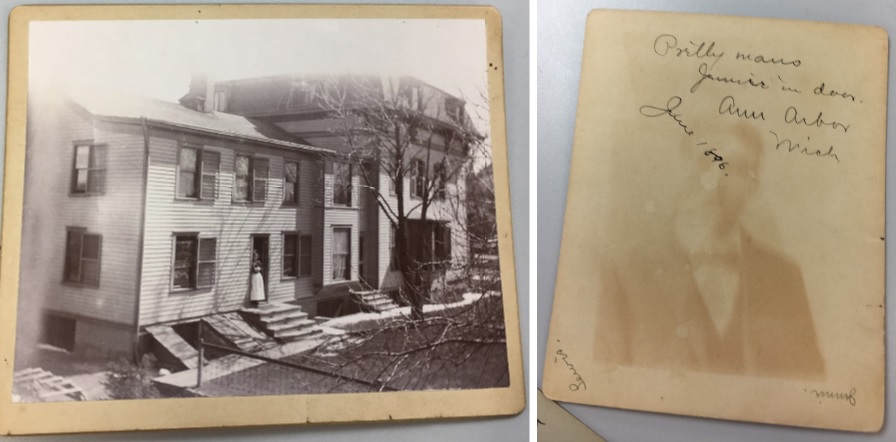
‘Prilly’ residence, a home that opened its doors to student boarders circa, June 1896.
Local institutions such as the Salvation Army of Washtenaw County and community churches also offered meals (Adams Lewis, 1898). The following essay offers a background on such boarding house culture and describes the rise of one particular University sponsored dorm, Mosher Jordan Hall, and the rarely discussed backlash that ensued over its construction.
Beginning as early as 1875, three primary boarding houses existed to serve primarily male students: ‘Prettyman’s’ Boarding House, later dubbed ‘Campus Club’ (1875, acquired by University in 1914), ‘Freeman’s’ and ‘Chubb’s’ (“Prettyman’s Boarding House”)).
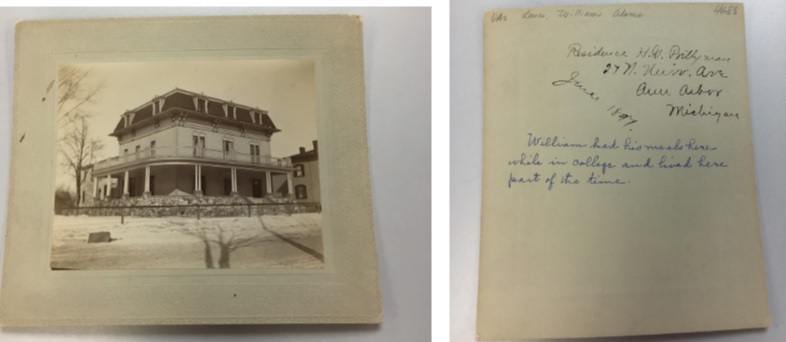
Prettyman’s Boarding House as seen in 1897. Note on reverse side reads: Residence H.G. Prettyman 27 N. Univ. Ave Ann Arbor, Michigan. June 1897 William had his meals here while in college and lived here part of the time.
Owned and operated by University alumnus and football team captain Horace Prettyman, the house served as an unofficial social hall for students and was regarded as a campus landmark, one of the ‘largest and the most popular of Ann Arbor’s boarding houses in the days when the vast majority of the student body used this type of service for their meals.’ Within these boarding houses, the proprietors offered a collegial atmosphere for lodgers, as seen below.
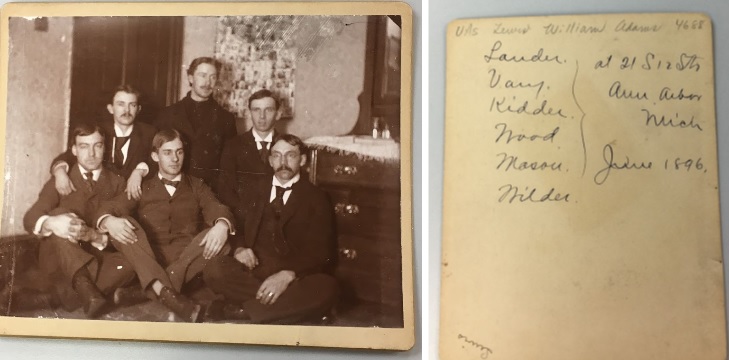
A group of student residents of 21 Six Street in Ann Arbor, circa June 1896.
It was to the chagrin of many alumni when these boarding houses closed. In the case of Chubb’s and Prettyman’s, the University purchased the lots at first to use as University sponsored housing. Later, the buildings were razed in order to make way for the Rackham Graduate School in the case of the former and the School of Dentistry in the case of the latter. (Michigan Alumnus issue from 1938).
It should be noted that many female students also took up residence with local Ann Arbor families during their time of study.
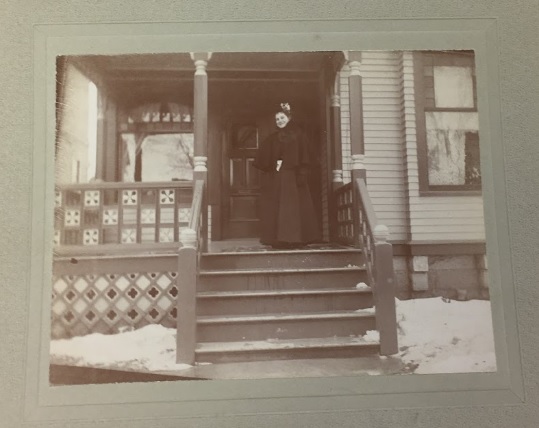
A female University student at a boarding house.
Beginnings of University-sponsored dormitories for women
As female enrollment increased, the University saw a need to provide suitable lodging for young women. In fact, beginning in the 1920s, the University set to open a large (for the time) dorm to house over 400 female students to be named Mosher-Jordan Hall (after Eliza Mosher and Myra Jordan, former women’s deans of the University of Michigan). At the onset, the University stated that in order to put student welfare first, University sponsored dorms offered a safe living space (appealing to parents) and a site of “valuable social training” (“Parents Desire Dormitories”- “Mosher-Jordan Halls (University of Michigan) photograph series- 1920s-1990s”).
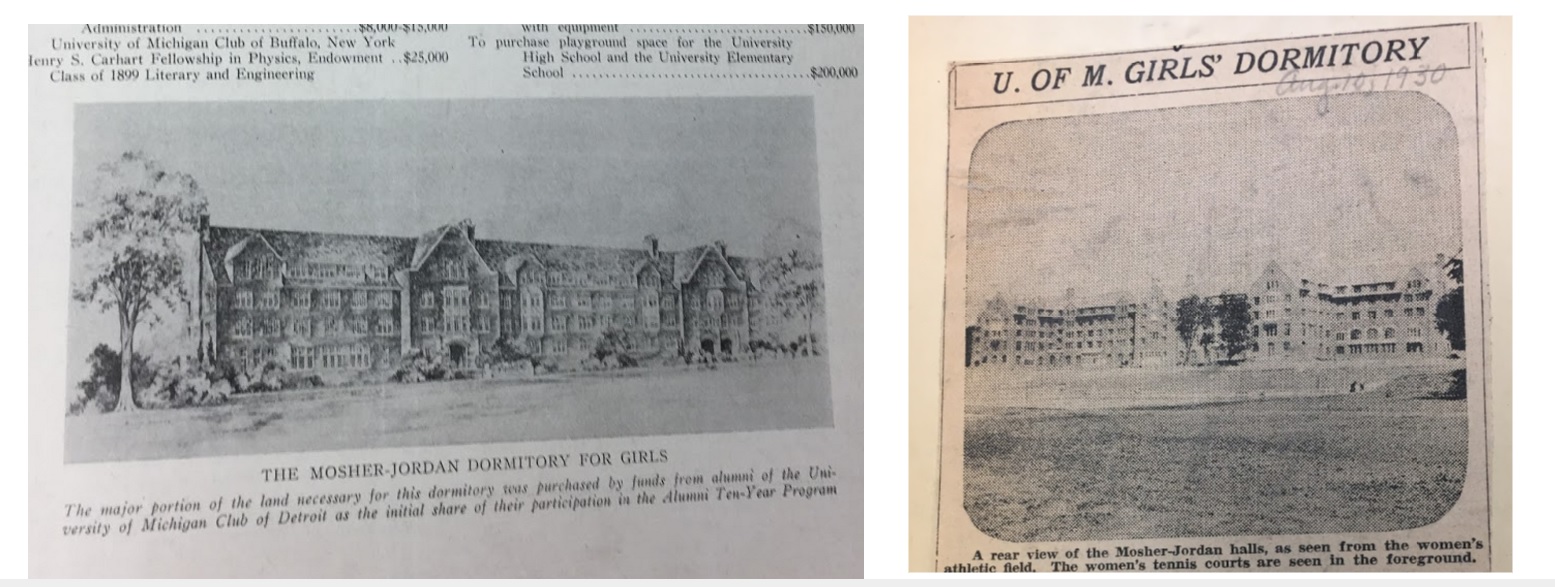
Early sketch of Mosher-Jordan Hall (left); Early photograph of the completed hall (right).
Among fairly routine delay setbacks included ability to secure financing, a search for an architectural team and severe weather, the University also faced significant opposition from private citizens of Ann Arbor who likely earned a significant amount of money from taking in students as boarders (“Building of Dormitory To Be Postponed”; “Dormitory Plans Near Completion”- “Mosher-Jordan Halls (University of Michigan) photograph series- 1920s-1990s”). A statement from the Regents of the University at the time of construction succinctly captures the tension:
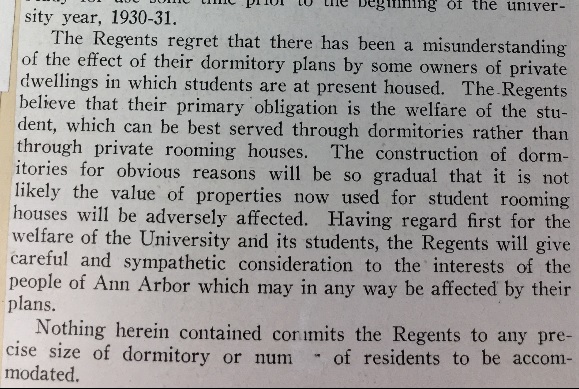
Statement from the Regents of the University in response to controversy
At the time regarded as a “thoroughly modern”, “giant structure” that was “one of the most imposing of the University of Michigan’s buildings because of its height and its location”, the $955,000 structure continued to be met with controversy among local residents. (“Contract let for Erection of Dorm”; “U of M Girls’ Dormitory”- “Mosher-Jordan Halls (University of Michigan) photograph series- 1920s-1990s”). In an article from the time of construction, it was noted that “work on the new dormitory was started following a controversy during which rooming-house owners of Ann Arbor sought by various means, including appeal to Governor Fred W. Green, to stop letting of the contract. It was felt by the group that the rooming houses are adequate and the dormitory unnecessary. Dr. Clarence C. Little, then president of the university, was made the butt of the attacks.” (“U of M Girls’ Dormitory”- “Mosher-Jordan Halls (University of Michigan) photograph series- 1920s-1990s”). It is clear that the University and the local residents did not see eye to eye then. Perhaps it is thought-provoking to consider how today, when University sponsored dormitories provide but a drop in the bucket for only nearly a quarter to a third of students, these relations have shifted.
Upon opening of the new dormitory, other female residence halls such as Martha Cook (1915), Helen Newberry (1915) and Betsy Barbour (1920) increased the cost of room and board to be equal to the going rate at Mosher-Jordan (“Boards Increase Dormitory Rent”, from February 2, 1930- “Mosher-Jordan Halls (University of Michigan) photograph series- 1920s-1990s”). Curious attention in the aforementioned cited article regarding rent was paid to the meals. It is noted in the subhead, “Meals Remain Uniform” (“Boards Increase Dormitory Rent”, from February 2, 1930- “Mosher-Jordan Halls (University of Michigan) photograph series- 1920s-1990s”). Additionally, great attention was paid to the nature and number of kitchens in the newly christened dorm, the place settings and draperies of the dining area (“Mosher-Jordan Halls, Women’s Dormitory, Now Near Completion as Contractors Finish Work”- “Mosher-Jordan Halls (University of Michigan) photograph series- 1920s-1990s”).
Nonetheless, it is clear that life at Mosher-Jordan created a camaraderie effect for its residents, recalling similar traditions of boarding house life but in a more structured, socially sanctioned setting. Subsequent years featured hall tea times, social dances, participation in sports league, entertainment of faculty members and families and house board elections (“Mosher-Jordan Holds Dances”, May 26, 1934- “Mosher-Jordan Halls (University of Michigan) photograph series- 1920s-1990s”). Despite this, strict rules remained in place for female residents regarding curfew and late policies (“Rigid Rules for Women’s Hours Passed”, May 30 1934- “Mosher-Jordan Halls (University of Michigan) photograph series- 1920s-1990s”).
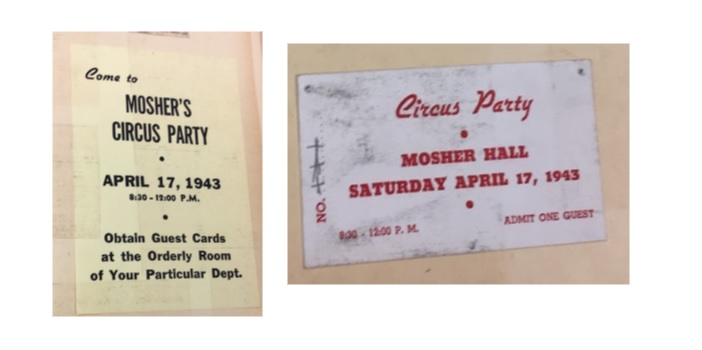
Examples of invitations and tickets to social gatherings at Mosher-Jordan hall.
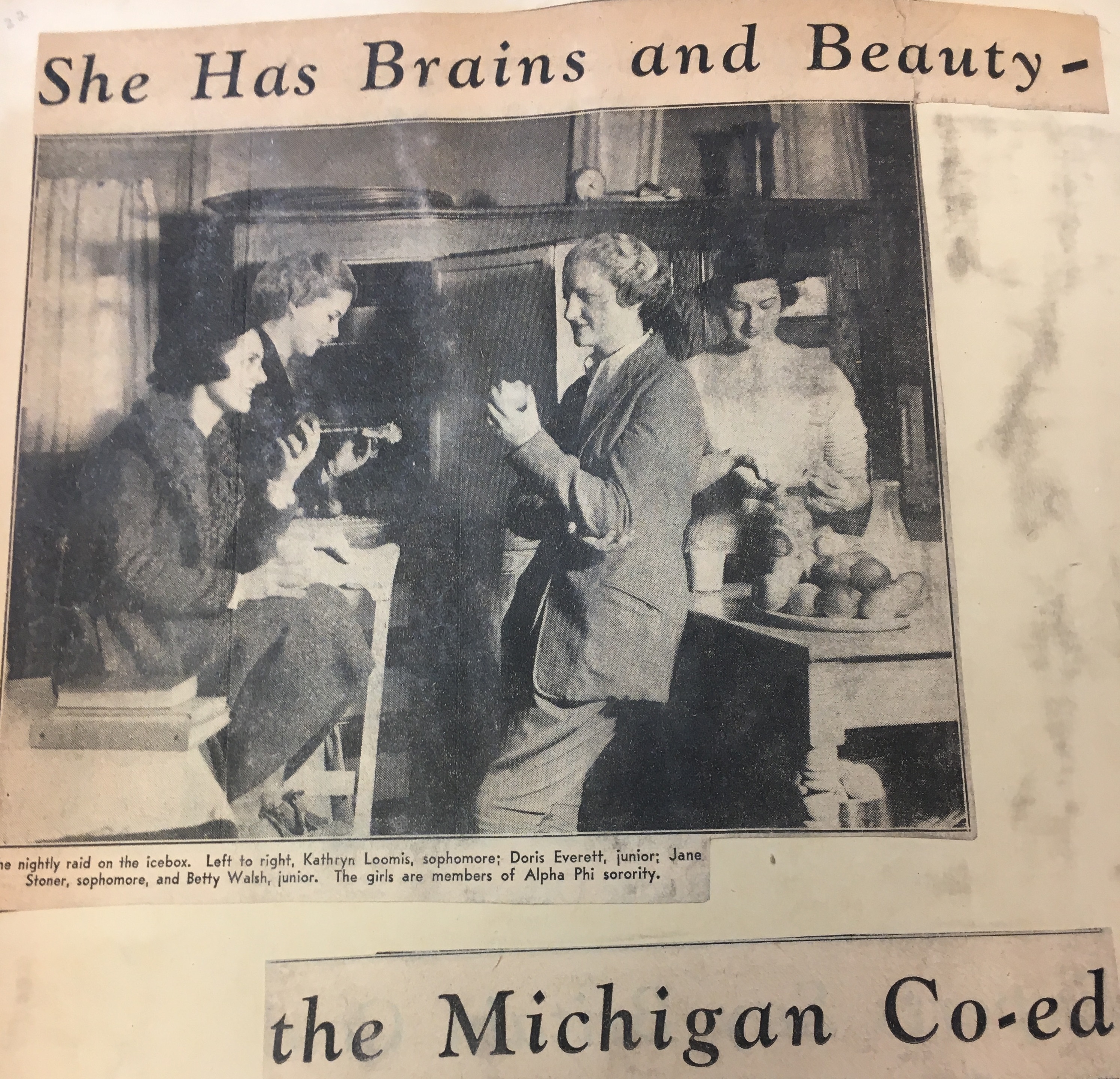
Clippings from newspapers at the time reveal how female University ‘co-eds’ were viewed at the time; based on their ‘brains and beauty.’
Upon learning the trajectory of local boarding houses and University development, it is insightful to consider the political and social ideologies at the time of construction. It is eye-opening to consider what norms have changed and what has remained the same. It is curious to consider in an age when the University does not hold itself responsible to the same degree for formal social training how off campus establishments reflect, as seen below in a new kind of social training:
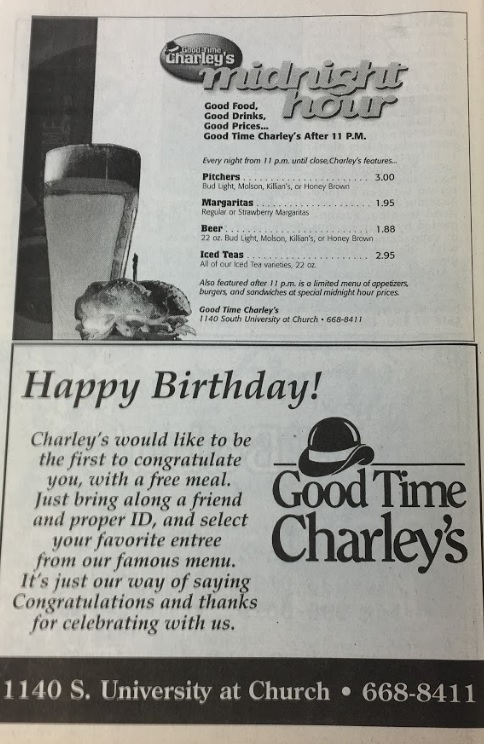
Contemporary ads shed light on new types of social training such as the first drink on one’s twenty-first birthday at a bar.
Sources
-
“A Chronology of University of Michigan Buildings, 1840-1999.” Bentley Historical Library. http://bentley.umich.edu/legacy-support/campus_tour/chronology.php
-
Adams Lewis, William. Collection of photographs and notebooks. 1893-1898.
-
Angell, James Burrill, 1829-1916. “James B. Angell Papers 1845-1916.” July-September 1900. The Bentley Historical Library. University of Michigan.
-
Kimball, Fiske. The Old Houses of Ann Arbor, 1919.
-
“Prettyman’s Boarding House.” University of Michigan Millennium Project. http://um2017.org/Ann-Arbor/Ann_Arbor_Maps/Prettymans_Boarding_Club.html
-
Mosher, Eliza Maria. “Eliza Maria Mosher Papers 1846-1934.” The Bentley Historical Library. University of Michigan.
-
“Mosher-Jordan Halls (University of Michigan) photograph series- 1920s-1990s.” Bentley Historical Library. University of Michigan.
-
“Tastes of Ann Arbor: a student’s guide to dining in Ann Arbor.” 2000.
-
“Famous Campus Landmark Disappears.” The Michigan Alumnus, vol. 45 (November 12, 1938), pp. 101. Accessed via: http://um2017.org/Ann-Arbor/Ann_Arbor_Maps/Prettymans_Boarding_Club.html
Image credits
-
Header image. “Mosher-Jordan Halls (University of Michigan) photograph series- 1920s-1990s.” The Bentley Historical Library. University of Michigan.
-
“‘Prilly’ residence…” Adams Lewis, William. Collection of photographs and notebooks. 1893-1898. The Bentley Historical Library. University of Michigan.
-
“Prettyman’s Boarding House as seen in 1897.” Adams Lewis, William. Collection of photographs and notebooks. 1893-1898. The Bentley Historical Library. University of Michigan.
-
“A group of student residents…” Adams Lewis, William. Collection of photographs and notebooks. 1893-1898. The Bentley Historical Library. University of Michigan.
-
“A female University student” Kimball, Fiske. The Old Houses of Ann Arbor, 1919.
-
“Early sketch of Mosher-Jordan Hall.” “Mosher-Jordan Halls (University of Michigan) photograph series- 1920s-1990s.” Bentley Historical Library. University of Michigan.
-
“Early photograph of the completed hall.” “Mosher-Jordan Halls (University of Michigan) photograph series- 1920s-1990s.” Bentley Historical Library. University of Michigan.
-
“Early photograph of the completed hall.” “Mosher-Jordan Halls (University of Michigan) photograph series- 1920s-1990s.” Bentley Historical Library. University of Michigan.
-
“Statement from the Regents…” “Mosher-Jordan Halls (University of Michigan) photograph series- 1920s-1990s.” Bentley Historical Library. University of Michigan.
-
“Examples of invitations…” “Mosher-Jordan Halls (University of Michigan) photograph series- 1920s-1990s.” Bentley Historical Library. University of Michigan.
-
“Clippings from…” “Mosher-Jordan Halls (University of Michigan) photograph series- 1920s-1990s.” Bentley Historical Library. University of Michigan.
-
“Contemporary ads…” “Tastes of Ann Arbor: a student’s guide to dining in Ann Arbor.” 2000. Bentley Historical Library. University of Michigan.